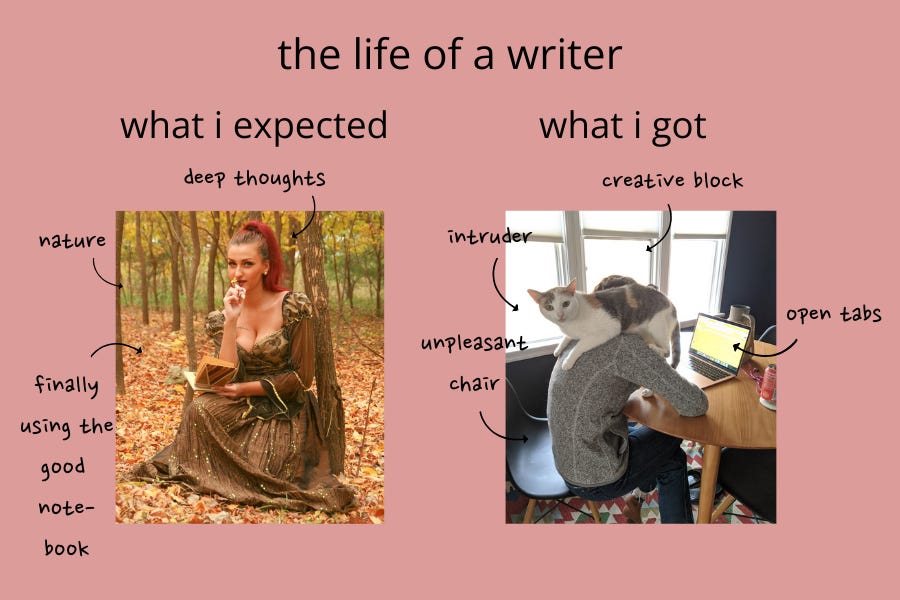Around this time last year, I was stuck in a big creative rut. I had lots of ideas bouncing around in my brain, but they all felt vague or overwhelming. Instead of starting any one of them, I’d overthink every detail until I got too tired to do anything. Or, I just talked myself out of it entirely.
By the end of the year, I had enough. I made a goal: dedicate 2024 to reconnecting with my creative side. I signed up for workshops, worked with an expert, and tried to figure out what it means to “be creative” in the first place. I thought I’d share a few things I discovered along the way.
The paradox of potential
When I started working with a creativity coach (hi Krystie 👋), I shared a fear I had about not reaching my potential. In the past, whenever I’d made something—a short film, a book, a newsletter—I would love it at first, only to cringe at it a year later, convinced I it could have been much better. For years now, this fear has kept me from starting anything new. What if the creative project doesn't live up to its potential?
Krystie offered a different perspective. She said something along the lines of, “Potential, by definition, is focused on the future. And you have no idea what your future self will think.” This blew my mind. There will always be a version of myself in the future that will be more skilled than I am now, so it’s impossible to live up to my future expectations, because by definition, I’m not there yet. I have no idea what those expectations are, so trying to please my future self will always be a pointless endeavor. Plus, I won’t get there until I do the work anyway. So I might as well just create the thing. Put simply, I’d rather create something and risk being disappointed by it than never create anything at all.
The difference between perfectionism and intuition
For a long time, I believed that "done is better than good." I saw so many talented writers paralyzed by perfectionism, unable to share their work. I didn’t want that to be me, so I would rush through projects just to finish them. But when my gut told me to slow down because something wasn’t working, I dismissed it as perfectionism and kept going. The problem? I could no longer tell the difference between a "gut feeling" and perfectionism. I wasn’t even sure I knew what intuition was.
In The Perfectionist’s Guide to Losing Control, Katherine Morgan Schafler writes, “A lot of perfectionists think they’re driven by success when what they’re really driven by is the avoidance of failure.” This really hit home for me. Perfectionism feels like fear—of failure or judgment—while intuition feels more like excitement about how something could improve. This has made it a lot easier to listen to my gut when something needs revision. I still avoid perfectionism, but that doesn’t mean I have to rush through a project, either.
Ideas belong to everyone
I’ve always loved the idea of the Duende—a mischievous creative force that visits us on its own terms. Elizabeth Gilbert echoes this in Big Magic, arguing that ideas don’t “belong” to anyone. Instead, she makes the case that ideas are more like entities that bounce around until they find the right person to bring them to life.
There’s something really useful about thinking of ideas in this way. It shifts the focus from ego to connection. Creativity isn’t something you own; it’s something you participate in. And approaching ideas this way makes the creative process feel less isolating and more collaborative. It’s also a reminder to be playful—creativity works best when I stop taking myself too seriously and hoarding my ideas out of fear that someone else will take them.
Work with what you have
Earlier this year, I worked on a Hidden Brain episode about how big ideas are born. It featured the work of Saras Sarasvathy, a researcher who spent years studying the world’s most successful innovators and visionaries. She found that they generate ideas and solve problems differently than most people. Instead of trying to predict the future or wait for the perfect opportunity, they focus on what they have right now.
They ask questions like, What resources are available? Who can help? How can setbacks become opportunities? This framework is focused on business, but it also transformed the way I approach creative projects. Instead of sticking to rigid plans or getting frozen by the pressure of “reaching my potential,” I’ve learned to adapt, experiment, and embrace where I am now. Creativity isn’t about having the perfect setup—it’s about making something out of what’s in front of me.
Be a little delusional
A little creative delusion can go a long way. In another Hidden Brain episode I worked on last year, we highlighted Justin Berg’s research on creativity. He found that artists with long careers, like Robert Zemeckis, often experience early failures because they refuse to follow trends. But sticking to their vision is what ultimately builds their legacy.
Optimists who stay true to their creative visions may risk failure, but they’re also the ones who achieve extraordinary success. The takeaway? Believing in your creative vision—especially when others can’t see it—can be risky, but it’s also what sets you apart.
We worked on this episode in 2023, but that lesson has been immensely helpful whenever the creative self-doubt popped up this year. Creativity is messy and unpredictable, but I’ve also learned that sometimes, I just have to show up and try, no matter how uncertain it all feels. Cheers to all of your creative endeavors.
See you in 2025,
Kristin





incredible perspective!
I totally agree, especially with the last piece of advice. Great writing as always! Happy 2025